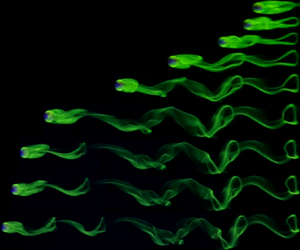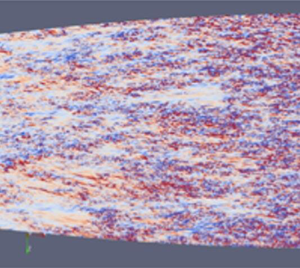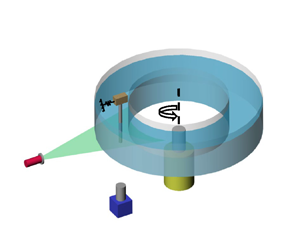doi:10.1017/jfm.2024.146 Nanayakkara et al. Effects of surface roughness on the drag coefficient of spheres freely rolling on an inclined plane
JFM Papers
Three-dimensional transition of the flow past an elastically mounted circular cylinder
-
- Published online by Cambridge University Press:
- 01 April 2024, A12
-
- Article
-
- You have access
- Open access
- HTML
- Export citation
Effects of surface roughness on the drag coefficient of spheres freely rolling on an inclined plane
-
- Published online by Cambridge University Press:
- 01 April 2024, A13
-
- Article
-
- You have access
- Open access
- HTML
- Export citation
An Earth-fixed observer to ship waves
-
- Published online by Cambridge University Press:
- 01 April 2024, A14
-
- Article
-
- You have access
- HTML
- Export citation
Laminar boundary layer separation and reattachment on a rotating sphere
-
- Published online by Cambridge University Press:
- 01 April 2024, A15
-
- Article
-
- You have access
- Open access
- HTML
- Export citation
Propagation instabilities of the oblique detonation wave in partially prevaporized n-heptane sprays
-
- Published online by Cambridge University Press:
- 01 April 2024, A16
-
- Article
-
- You have access
- HTML
- Export citation
Evaporation of acoustically levitated bicomponent droplets: mass and heat transfer characteristics
-
- Published online by Cambridge University Press:
- 01 April 2024, A17
-
- Article
-
- You have access
- Open access
- HTML
- Export citation
Hydrodynamic metamaterial redirector for steering fluid flow in pipelines with arbitrary curvatures
-
- Published online by Cambridge University Press:
- 01 April 2024, A18
-
- Article
-
- You have access
- HTML
- Export citation
Flow–acoustic resonance mechanism in tandem deep cavities coupled with acoustic eigenmodes in turbulent shear layers
-
- Published online by Cambridge University Press:
- 05 April 2024, A19
-
- Article
-
- You have access
- HTML
- Export citation
Reynolds number effects in separating and reattaching flows with passive scalar transport
-
- Published online by Cambridge University Press:
- 02 April 2024, A20
-
- Article
-
- You have access
- Open access
- HTML
- Export citation
A PINN approach for identifying governing parameters of noisy thermoacoustic systems
-
- Published online by Cambridge University Press:
- 01 April 2024, A21
-
- Article
-
- You have access
- HTML
- Export citation
Spatial growth rates of young wind waves under steady wind forcing
-
- Published online by Cambridge University Press:
- 01 April 2024, A22
-
- Article
-
- You have access
- Open access
- HTML
- Export citation
A streamline coordinate analysis of a turbulent boundary layer subject to pressure gradients and curvature on the windward side of a bump
-
- Published online by Cambridge University Press:
- 01 April 2024, A23
-
- Article
-
- You have access
- Open access
- HTML
- Export citation
On the shear-induced lift in two-way coupled turbulent channel flow laden with heavy particles
-
- Published online by Cambridge University Press:
- 01 April 2024, A24
-
- Article
-
- You have access
- HTML
- Export citation
Diffusive-convection staircases in the polar oceans: the interplay between double diffusion and turbulence
-
- Published online by Cambridge University Press:
- 01 April 2024, A25
-
- Article
-
- You have access
- Open access
- HTML
- Export citation
Active spheroids in viscosity gradients
-
- Published online by Cambridge University Press:
- 01 April 2024, A26
-
- Article
-
- You have access
- HTML
- Export citation
A canonical Hamiltonian formulation of the Navier–Stokes problem
-
- Published online by Cambridge University Press:
- 01 April 2024, A27
-
- Article
-
- You have access
- Open access
- HTML
- Export citation
Universal relative scaling of longitudinal structure functions in shear-dominated turbulence
-
- Published online by Cambridge University Press:
- 01 April 2024, A28
-
- Article
-
- You have access
- Open access
- HTML
- Export citation
Buoyancy oscillations
-
- Published online by Cambridge University Press:
- 03 April 2024, A29
-
- Article
-
- You have access
- HTML
- Export citation
Elimination of lock-in phenomenon in vortex-induced vibration by passive modal control
-
- Published online by Cambridge University Press:
- 02 April 2024, A30
-
- Article
-
- You have access
- HTML
- Export citation
Instability in strongly stratified plane Couette flow with application to supercritical fluids
-
- Published online by Cambridge University Press:
- 02 April 2024, A31
-
- Article
-
- You have access
- Open access
- HTML
- Export citation


































































